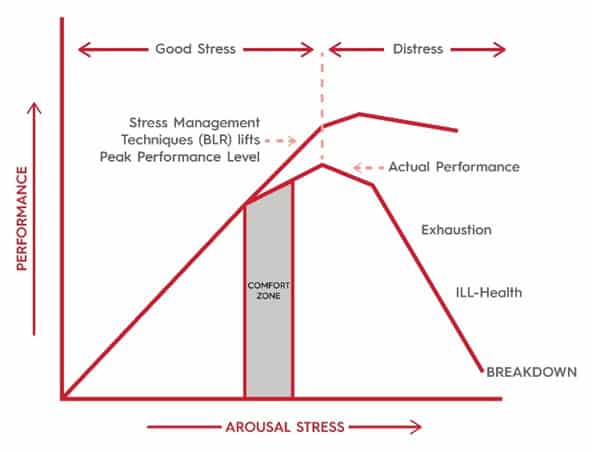How much stress do we need to perform?

As a CEO, you have a high level of responsibility. Combine that with the ‘always-on’ modern workplace surrounded by ever-changing technology, endless emails and back-to-back meetings, it’s no wonder many feel overwhelmed by stress every now and then. Yet we also need the stimulation of the work, along with the deadlines that must be met. This is what helps you challenge yourself to innovate, make strategic improvements – and avoid getting too comfortable.
Understanding how you balance this tension to perform at your best starts with learning how your brain is wired.
Threat versus reward state
If you feel negative emotions at work like frustration, anxiety, anger or impatience, you create a threat state – which makes you less focused. You have fewer insights, become more risk averse and feel less connected to others.
On the flip side, positive emotions create a reward state – leading to clearer thinking, more insights and a solution focus. And that means better performance.
So it all starts with how you perceive the problem you are facing. See it positively as an opportunity, and you will have greater capabilities on call. The pre-frontal cortex (PFC) experiences greater blood flow – this is where you make decisions about how to perceive things. In other words, our ability to make decisions is fundamentally shifted just by our perception of our ability to make a decision.
Determine your own stress response
Once you understand this, you can regulate your emotions so it’s easier to achieve (and maintain) a ‘reward state’. How do you respond to perceived threats? Do you know when you are not performing well? As this graph shows, your answers can help you pinpoint the moment where ‘good’ stress has a positive impact on performance.
In your ‘comfort zone’ you may experience some arousal stress but not enough to perform at your peak. Some people are happy to remain in a comfort zone, others may like more stimulation. You might even be addicted to the ‘rush’ of being at the edge of peak performance.
But when you experience too much arousal stress, there can be a sudden drop-off in performance. You start to experience black-and-white thinking, and go into a threat state.

What happens if you cross the line?
In this over-arousal state, the brain automatically processes things differently. The amygdala activates the ‘fight, flight, freeze’ response. Blood flows to your heart and lungs – and away from the PFC.
If you experience this state of anxiety regularly, it changes the way your brain perceives the world and, over time, causes physical changes in the brain. Your behaviours are constantly driven by threat-avoidance, creating a vicious cycle. The brain perceives more threats – even if they are not there – which in turn causes more stress. And chronic stress narrows your focus, damages the brain and reduces immune functions.
So it’s important to understand where your own comfort zone is. At this point, a bit of a stretch will get you to peak performance.
Are men and women different?
Yale’s Professor of Neuroscience and of Psychology Amy Arnsten has studied the prefrontal cortex for 25 years. She found that on average, men sit in the performance comfort zone naturally. They are almost at the top near peak performance, but need more arousal stress to get to peak performance.
Women, however, sit on the top of the arousal curve. They are more likely to be naturally at peak performance, but go into distress more easily.
Obviously, we can’t generalise gender behaviours too much – every individual is different and I have seen many men and women who sit elsewhere on the curve. So think about where you sit as a CEO, and ask yourself: do I need more arousal stress to perform at my best? Or do I perform at my peak when I am less stressed?
The right amount of stress
The PFC is very fussy. It needs exactly the right chemical mix for peak performance, but the perfect formula is different for everyone. Once you understand this mechanic in yourself, you’ll find it easier to recognise it in others. You’ll also be able to harness your brain’s decision-making capability more effectively – which can lead to smarter strategic decisions for your organisation.
*Note: Image in the article Adapted from Nixon P, Practitioner, 1979.
Bring the best of the CEOWORLD magazine's global journalism to audiences in the United States and around the world. - Add CEOWORLD magazine to your Google News feed.
Follow CEOWORLD magazine headlines on: Google News, LinkedIn, Twitter, and Facebook.
Copyright 2025 The CEOWORLD magazine. All rights reserved. This material (and any extract from it) must not be copied, redistributed or placed on any website, without CEOWORLD magazine' prior written consent. For media queries, please contact: info@ceoworld.biz








